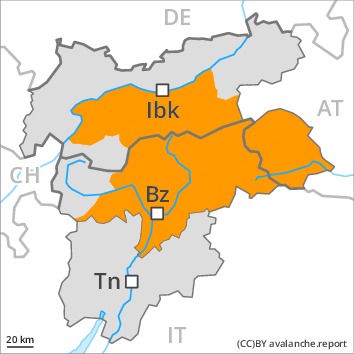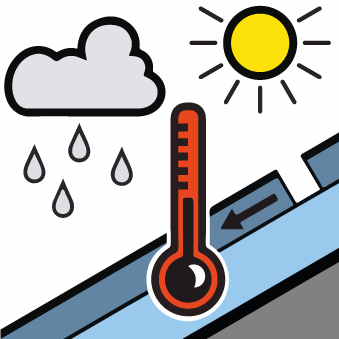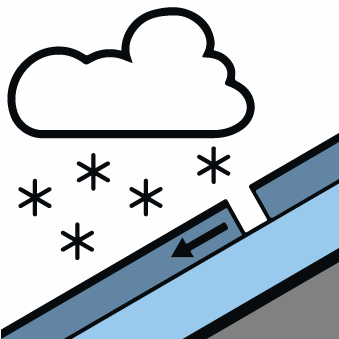
Danger level
 | treeline
|
Avalanche Problem
 | | Wind-drifted snow |
|  | |  |
 | | Gliding snow |
|  | |  |

Wind slabs represent the main danger. Caution is to be exercised in areas with glide cracks.
The new snow and wind slabs of the last few days are lying on soft layers in all aspects above the tree line. Avalanches can be released by a single winter sport participant and reach medium size. Dry avalanches can additionally be released in the weakly bonded old snow. In isolated cases these are large. Remotely triggered avalanches are possible.
Especially in places that are protected from the wind and at high altitudes and in high Alpine regions individual natural avalanches are possible as a consequence of the strong to storm force northwesterly wind. Caution is to be exercised in case of releases originating from starting zones that have retained the snow thus far.
In the regions with a lot of snow gliding avalanches are possible, even quite large ones. In the regions where rain falls the avalanche danger is greater.
Meticulous route selection is required.
Snowpack
dp.6: cold, loose snow and wind
dp.2: gliding snow
In particular in the north and in the northwest 15 to 30 cm of snow, and even more in some localities, has fallen above approximately 1500 m. In the south a little new snow.
Over a wide area 5 to 10 cm of snow will fall above approximately 1500 m. Strong northwesterly wind. The wind will transport the fresh and old snow. In some places new snow and wind slabs are lying on soft layers. Distinct weak layers exist in the centre of the snowpack. Towards its base, the snowpack is largely stable.
The rain gave rise to a loss of strength within the snowpack in particular at low altitude.
Tendency
As a consequence of mild temperatures the snow drift accumulations will stabilise.

Danger level
 | treeline
|
Avalanche Problem
 | | Wind-drifted snow |
|  | |  |
 | | Wet snow |
|  | |  |

For those venturing off piste a sometimes unfavourable avalanche situation will prevail.
Numerous small to medium-sized avalanches occurred naturally.
The fresh and somewhat older wind slabs are sometimes thick and can in some cases be released easily especially at their margins. This applies above the tree line. The prevalence of avalanche prone locations and likelihood of triggering will increase with altitude.
In addition in particular at low and intermediate altitudes, further wet and gliding avalanches are possible.
Meticulous route selection is recommended.
Snowpack
dp.6: cold, loose snow and wind
dp.3: rain
Over a wide area 20 to 50 cm of snow, and even more in some localities, has fallen since Tuesday above approximately 1500 m.
5 to 10 cm of snow will fall on Saturday above approximately 1500 m. Strong northwesterly wind. The wind will transport the fresh and old snow. In some places new snow and wind slabs are lying on soft layers. This applies at high altitude.
Avalanche prone weak layers exist in the centre of the snowpack. Towards its base, the snowpack is faceted.
The rain gave rise to increasing softening of the snowpack especially at low altitude.
Tendency
The avalanche danger will decrease gradually.

Danger level
 | treeline
|
Avalanche Problem

A critical avalanche situation will persist.
Numerous avalanches occurred naturally.
Especially in places that are protected from the wind and at high altitudes and in high Alpine regions more natural avalanches are possible as a consequence of the strong to storm force northwesterly wind, caution is to be exercised in particular in case of releases originating from starting zones that have retained the snow thus far. The snowpack will be moist at low and intermediate altitudes. This has a decelerating effect on the avalanches.
In addition in particular at low and intermediate altitudes, further wet and gliding avalanches are possible.
The large quantity of fresh snow and the extensive wind slabs formed during the snowfall can be released by a single winter sport participant at high altitudes and in high Alpine regions. Avalanches can penetrate deep layers and reach quite a large size. The prevalence of avalanche prone locations and likelihood of triggering will increase with altitude.
Extensive experience in the assessment of avalanche danger and great restraint are required.
Snowpack
dp.6: cold, loose snow and wind
dp.3: rain
Over a wide area 40 to 70 cm of snow, and even more in some localities, has fallen since Tuesday above approximately 1500 m.
20 cm of snow will fall on Saturday above approximately 1500 m. Strong northwesterly wind. The wind will transport the fresh and old snow. In some places new snow and wind slabs are lying on soft layers. This applies at high altitudes and in high Alpine regions.
Distinct weak layers exist in the centre of the snowpack. Towards its base, the snowpack is faceted.
The rain gave rise to increasing softening of the snowpack especially at low altitude.
Tendency
The avalanche danger will decrease gradually.












